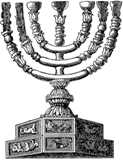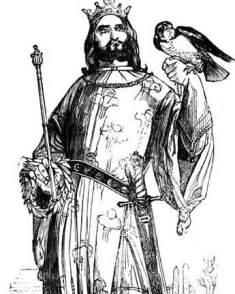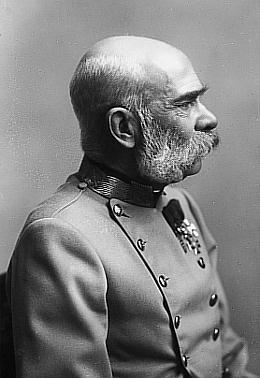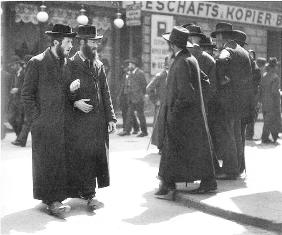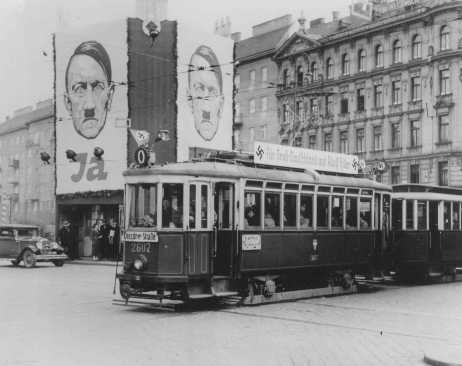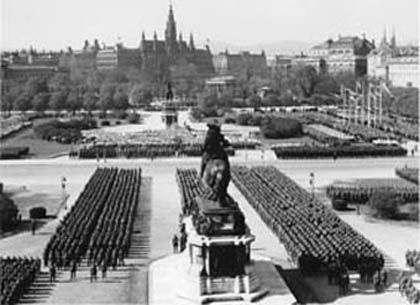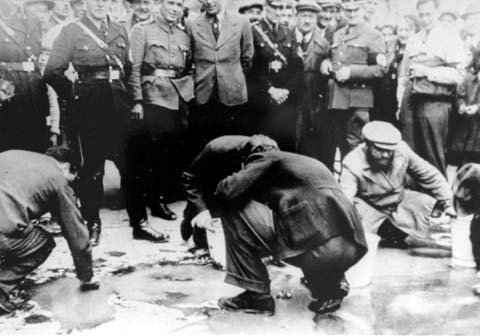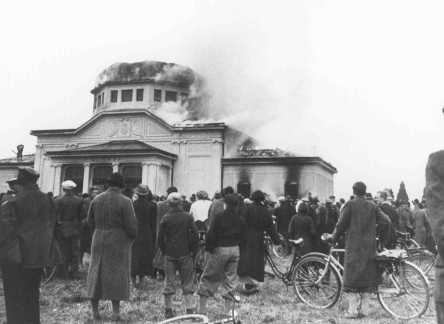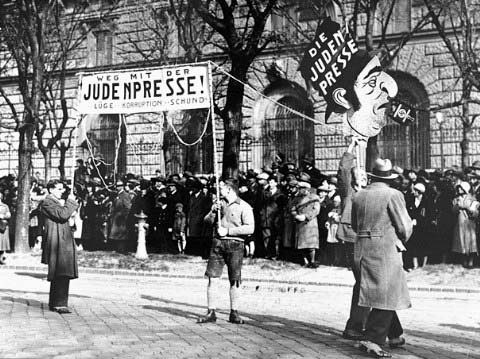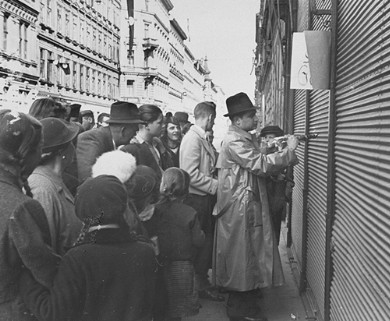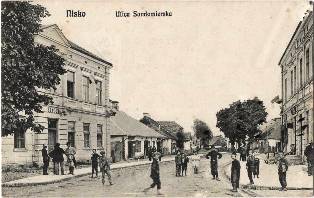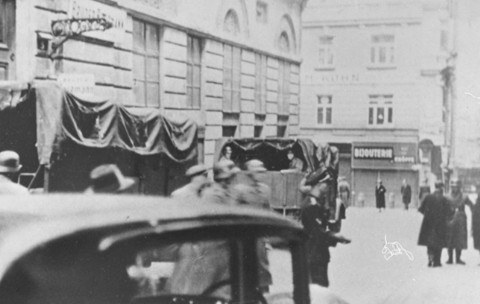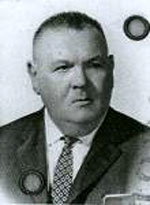Anschluss
On 12 February 1938 Adolf Hitler met the Austrian Chancellor Kurt von Schuschnigg at Berchtesgarden, in an attempt to force him to lift the ban on the Austrian National Socialists party and release all imprisoned members of the Nazi party and let them participate in the government.
Schuschnigg refused and took steps to prepare for the defense of Austria, however over the ensuing weeks realized that he was being undermined by his own cabinet ministers who conspired to have him removed from office. Schuschnigg retaliated by trying to gather support throughout Austria and inflame patriotism among the people.
On March 9th, 1938 he called a referendum for a "Independent Christian Austria" and to better his odds at winning the plebiscite, he had the the minimum voting age increased to 24 in order to exclude younger voters who largely sympathized with Nazi ideology.
|
Hitler used this action as a pretext to to call the referendum a fraud and would not be recognized by Germany. Goebbels issued press reports that riots had broken out in Austria and that large parts of the Austrian population were calling for German troops to restore order.
An ultimatum was sent by Hitler demanding that Schuschnigg hand over all power to the Austrian National Socialists or face an invasion. Schuschnigg realizing that neither France nor England was willing to take steps to prevent the Nazi ultimatum, resigned as Chancellor that same evening.
President Wilhelm Miklas of Austria refused to appoint the Austrian Nazi leader Arthur Seyss-Inquart as chancellor. The German Nazi minister Hermann Göring ordered Seyss-Inquart to send a telegram requesting German military aid, but he refused, and the telegram was sent by a German agent in Vienna.
On March 12 Germany invaded, and the enthusiasm that followed gave Hitler the cover to annex Austria outright on March 13. A controlled plebiscite of April 10 gave a 99.7 percent approval. The Wehrmacht troops encountered no resistance.
Two days later an estimated 100,000 people gathered outside the Heldenplatz to celebrate Hitlers entrance into Vienna and the union of Austria and the German Reich.
Days of terror
Jews in Vienna forced to scrub Schuschnigg's slogans off the sidewalk |
After the Anschluss many Jews tried to emigrate out of Austria. The city of Vienna with its large Jewish population, suffered first from the intensified anti-Jewish measures imposed on the community. However it was not only Jews, but also Catholics and other opponents of the Nazi regime that were imprisoned, tortured and driven to suicide.
Some 76,000 people were arrested in the days following the "Anschluss," and a first convoy carrying 151 Nazi opponents set off for the Dachau concentration camp near Munich on April 1.
But in most cases it was the Jews who were hit hardest. Universities, from which Jews were banned, lost over 40 percent of their students and professors in a matter of hours.
Many had their property confiscated, their homes looted or appropriated, and the ensuing lawlessness and corruption by the Nazi officials was so rampant that some were even arrested, and investigated by the Gestapo for misappropriation of Reich property.
In August 1938, Adolf Eichmann established the "Zentralstelle fuer juedische Auswanderung" in Vienna. This organization was to be responsible for the "solution of the Jewish problem" in Austria. Its "efficient" methods of persecution and deportation were later copied in Germany and in several of the Nazi-occupied countries.
A special body, the Vermoegensverkehrsstelle or; "asset transfer office" was responsible for the transfer of Jewish property to non-Jews. With the help of the major Jewish welfare organizations in the world, the community and the Palestine Office were able to assist in the emigration of thousands of Jews.
The importance of this aid grew with the straitened circumstances of Austrian Jewry; as against 25% of the emigrants who needed financial assistance in May and July 1938, 70% needed assistance in July and August 1939. Between July and September 1938 emigration reached a monthly average of 8,600.
|
After Kristallnacht on November 9, 1938, the situation for Jews in Austria worsened and more sought to leave. However, the options of where to flee were limited. Several hundred were able to leave for the U.S.A., Palestine and Shanghai, but it was only England - under pressure - that took Jews by the thousands.
During the pogroms of November 10 (see *Kristallnacht), approximately 8,000 Jews were arrested, and of these 5,000 were sent to Dachau. Six hundred and eighty others committed suicide or were murdered that single night.
In Vienna alone, 42 synagogues were burned and 4,038 Jewish shops were looted. Almost all Jewish homes were destroyed and cemeteries desecrated. Synagogues were also destroyed in Graz, Salzburg, Klagenfurt, Linz, Innsbruck, Baden, Eisenstadt, Berndorf, and Bad Voeslau.
In Linz, all the Jewish inhabitants were arrested, and all Jews in the district were ordered to move to Vienna within three days. One-third of the fine of a billion marks ($83,300,000) imposed on the whole of the German Reich Jewry was levied on Austrian Jews. By May 1939 around 100,000 Austrian Jews had emigrated.
The Director of the Organization Department of the World Zionist Organization Leo Lauterbach outlined the situation of the Austrian Jews in his 1938 letter to fellow Zionist leaders in London:
...Generally speaking the situation in Vienna seemed to be, both on the non-Jewish and the Jewish side, characterized by confusion, uncertainty and a state of flux. The mission of Sir Wyndham Deedes was greatly handicapped by the fact that, at the time of his and my visit, there seemed to be no established authority from whom the official policy could be reliably ascertained and whose intervention could be solicited.
The position might have changed since, but at the time it appeared that the chief authority was vested in the Gestapo, whose officials were at that time in Berlin and who, as we learned there afterwards, returned to Vienna with, it was stated, a full measure of independence from their headquarters in Berlin.
Possibly the Gestapo are now under instructions from Herr Buerckel. A clear policy with regard to the Jewish problem in Austria has neither been announced in public, nor was it conveyed to us in the few interviews we succeeded in having. One cannot, however, avoid the impression that this policy will be essentially different from that adopted in Germany and that it may aim at a complete annihilation of Austrian Jewry. To all appearances, it is intended to eliminate them from economic life, to deprive them of all their financial resources, and to compel them either to starve or to leave the country without means, at the expense of the great Jewish organizations abroad and with the help of such countries as may be willing to receive them.
For reasons of their own the authorities seem to wish to deal with Austrian Jews without any interference by the Jews in Germany. One cannot help feeling that, after the protracted campaign of intimidation, the Jews of Austria have become a pliable instrument in the hands of their oppressors, who may think that they will achieve their ends more easily if they deal directly with people whose moral backbone has been broken.
If this analysis is correct, no effort should be spared on our side to counteract such tendencies and to give the Austrian Jews not only material support, but also moral encouragement. For that purpose it would seem to be the most urgent task of the moment to delegate to Austria representatives of the great Jewish and Zionist organizations abroad who, with permission of the authorities, would be allowed to act there, even if only temporarily, as advisers and helpers of the local leaders. In addition, any future financial support given by Jewish institutions abroad ought to be made dependent as far as possible upon the establishing of a permanent contact between the Jewish institutions in Vienna and those in Berlin.... -(sgd) Leo Lauterbach London, 29th April, 1938 |
In 1939 the Nazis began the systematic annihilation of the Austrian Jewish population. In the summer of the same year hundreds of factories and Jewish stores were shut down by the Austrian government. Later in October, over one thousand youth and elderly Jews were deported to Buchenwald and in the same month two additional transports were sent to the Nisko area of Poland.
A report by the Central Office for Jewish Emigration, October 18, 1939 regarding Jews being sent to Nisko stated the following:
Further to the Note on the conversation between SS Hauptsturmbannfuehrer Eichmann, Dr. Ebner of the Gestapo and the Special Representative of Reichskommissar Dr. Becker, it is stated that the Resettlement operation to Poland will begin at 22.00 hours on October 20, 1939, with the first transport of 1,000 Jews fit for work, from the Aspang Rail Station in Vienna.
The Jews were supplied by the Jewish Community with tools for the erection of a barracks village at Nisko, where transports of Jews fit for work have already been sent from Maehrisch-Ostrau. The Jews on the transport will also be given foodstuffs for 4 weeks.
Further transports will leave regularly on Tuesdays and Fridays of each week with 1,000 Jews. The second and third transports will consist of Jews and Jewesses at present under arrest in Vienna, whose departure date has been set by the Gestapo. From the fourth transport on, complete families will already be sent.
When the barracks village at Nisko has been completed, the Jews who arrived with the first transport will in continuous progression be distributed to the interior to the formerly Jewish villages in that area.
The composition of the transports is arranged by the Jewish Community of Vienna (as long as this remains possible) and a Jewish transport management is responsible for the transports. In addition, each transport is accompanied by 25 police (Schupo) officers under the command of a police captain, who must prevent all danger of escape by use of arms. |
Scene during an SS raid on the Viennese Jewish community offices |
By December 1940, there were still about 50,000 to 60,000 Jews living in Vienna. They were mostly unemployed, evicted from their homes and living with other families, crammed into "collective" apartments, their bank accounts blocked or frozen; in short, they were barely surviving.
At in the start of the new year of 1941 all Jews were forbidden to exit the boundaries of Austria and up to that time only about 28,000 managed to flee the country as the death process began to build momentum. In June, 1942 a transport left Vienna and went directly to the Sobibor extermination camp delivering around 1000 Jews to be murdered.
October 15, 1941 marked the beginning of the first systematic deportations of Jews from Vienna to the Lodz Ghetto but large number of Jews were also sent to the Mauthausen Concentration Camp outside of Linz. By the end of the winter of 1941, an additional 4,500 Jews were sent from Vienna to different concentration and extermination camps in Poland.
In February and March 1941, about 5,000 Jews were deported to Kielce, Poland, from whence they were sent in 1942 to the Belzec.
After the Wannsee Conference, Eichmann announced to the Viennese community his general Aussiedlung ("evacuation") program under which 3,200 more Austrian Jews were deported to Riga, 8,500 to Minsk, and 6,000 to Izbica and several other places in the Lublin region. This last group was almost entirely exterminated.
On June 1, 1942 Eichmann Informed the Jews on Deportations from Austria to the Theresienstadt Ghetto:
Vienna, June 1, 1942 Memorandum on the visit to the Reich Security Main Office, Reich Ministry of the Interior, Department IV B 4, on Friday, May 29, 1942, at 10:30 A.M. and to SS Obersturmbannfuehrer Eichmann on Saturday, May 30, 1942, at 12:00 noon at the same office.
1. In accordance with an order received I reported to the Reich Security Main Office, Dept. IV B 4, on May 29, 1942, together with Dr. Benjamin Israel Murmelstein, the six members of the Presidium of the Reichsvereinigung der Juden in Berlin: Baeck, Eppstein, Henschel, Kozower, Kreindler and Lilienthal, as well as the two representatives of the Jewish Community of Prague: Janovic and Friedmann. There we were informed that in connection with a sabotage attack on the exhibition "The Soviet Paradise" in Berlin, in which five Jews had been actively involved, 500 Jews had been arrested in Berlin and of these 250 had been shot and 250 sent to a camp. We were further informed that additional measures of this kind were to be expected in the event of any other act of sabotage in which Jews took part. An instruction was given that this position was to be made known to the Jews in a suitable manner in order to make clear to them what the result of such acts would be.
2. During the visit to SS Obersturmbannfuehrer Eichmann I reported on the situation in Vienna, the position [reached] by the emigration transports, the probable number of Jews over 65, who were to be taken to Theresienstadt for permanent residence, as well as on financial questions. SS Obersturmbannfuehrer Eichmann informed me that the total evacuation of the Jews was planned from the Altreich [Germany before 1938], the Ostmark [Austria] and the Protectorate. Jews under 65 years old would emigrate to the East, and those over 65, as well as some groups of those under 65, such as men seriously disabled in the War, and those who received medals in the World War, etc., would be sent to Theresienstadt for permanent residence.
In accordance with the Regulation of February 16, 1942, the Czechs living in Theresienstadt must leave the locality by May 31, 1942, so that the entire area of the city will be available for the Jews. After this a start will be made on transporting the Jews designated for permanent residence there. The administration of the city is to be carried out independently by the Council of Jewish Elders (Judenaeltestenrat). In addition to the old people, several thousand young people are to remain there in order to carry out necessary work in the city and countryside (about 640 (?) acres of land are available) and to look after the old people.
Institutions necessary for the maintenance of the Jews are also to be set up or, where possible, existing institutions will be enlarged. According to the instructions of the Council of Elders the Jews will be accommodated partly in the existing large barracks, or privately in the houses. A part will be catered for in communal kitchens, and a part privately. In addition to personal luggage of up to 50 kgs. per person, a large quantity of equipment and furniture for apartments and dormitories, as well as tools, are to be sent to Theresienstadt. The number of items of this type will be decided on each occasion by the Central Office for Jewish Emigration in Vienna, in accordance with the freight cars available.
Special importance will be accorded to the provision and maintenance of sanitary installations. Good doctors and nurses will go to Theresienstadt to look after the health of the Jews and, in particular, to prevent epidemics. This will also to a large extent be the task of the Council of Elders. The financial maintenance of the Jewish population settled in Theresienstadt will be provided by the funds of the three organizations, the Reichsvereinigung der Juden in Berlin, and the Jewish Communities of Vienna and Prague. These organizations in general have considerable funds at their disposal.
The budget will be decided in accordance with requirements for certain periods at a time, and the necessary sum made available to the Council of Elders in Theresienstadt. The capacity of Theresienstadt to accommodate Jews is quite large. When I was asked how many Jews from Vienna might be considered for Theresienstadt, I named a figure of about 12,000 persons; SS Obersturmbannfuehrer Eichmann declared that the number of Jews from Vienna could be settled there.
I pointed out that a total evacuation of Jews from Vienna was scarcely possible, because as a result of the large-scale emigration and the unusually high age of the remaining population there is a disproportionate number of aged and sick persons, who must be considered as incapable of travelling. In any case a fairly large number of Jews will remain in Vienna owing to the exclusion from deportation of [members of] Jewish mixed marriages.
I also asked that a part of the Jews designated for emigration, particularly the children at present in youth and children's homes, who are under my care as guardian of orphans, should be sent to Warsaw with the personnel looking after them, because I could then be sure that they will receive the proper care and attention in a large Jewish center. SS Obersturmbannfuehrer Eichmann declared that the destination for emigration was decided together with departments of the Wehrmacht, and that it was not possible to say in advance where the transports would go; he would see what could be done in this matter.
- signed Dr. Josef Israel Loewenherz General Director and Head of the Jewish Community, Vienna |
Between June and October, 13,900 people were deported to Theresienstadt, most of them aged 65 and over. On Oct. 10, 1942, the last transport of 1,300 persons left for Theresienstadt. The Viennese Jewish community was then officially dissolved on Nov. 1, 1942, but still remained 7,000 Jews in Austria.
Deportations to the East continued, albeit at a slower pace, and by the end of the war only 1,000 Jew survived in Vienna.In the summer of 1943, there were still approximately 800 Jews left in Vienna. They had gone underground and were secretly helped by members of the community and the Budapest Jewish rescue committee.
SS men supervise the confiscation of goods belonging to Jews deported from Vienna |
A few managed to escape to Hungary, but many others were caught by the Gestapo and sent to Auschwitz. Some managed to stay underground until Vienna fell to the Soviet Army.
In total, some 65,000 Austrian Jews were assassinated under the Third Reich and 130,000 were forced into exile, including the father of psychoanalysis Sigmund Freud, painter Oskar Kokoschka and several Nobel Prize winners and scientists.
Of the approximately 50,000 Jews deported from Austria to ghettos and extermination camps only 1,747 returned to Austria at the end of the war. The largest group of survivors, which numbered 1,293, was liberated from the Theresienstadt Ghetto).
Soviet and American forces occupied Austria in April and May 1945.
